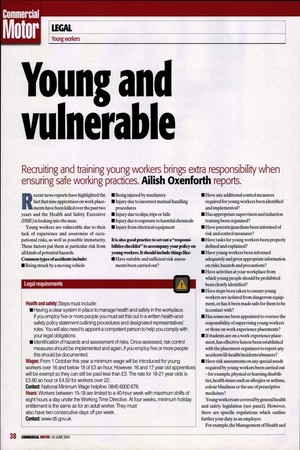Young and vulnerable Recruiting and training young workers brings extra responsibility when
Page 40

Page 41

If you've noticed an error in this article please click here to report it so we can fix it.
ensuring safe working practices. Ailish Oxenforth reports.
Recent news reports have highlighted the fact that nine apprentices on work placements have been killed over the past two years and the Health and Safety Executive (HSE) is looking into the issue.
Recent news reports have highlighted the fact that nine apprentices on work placements have been killed over the past two years and the Health and Safety Executive (HSE) is looking into the issue.
Recent news reports have highlighted the fact that nine apprentices on work placements have been killed over the past two years and the Health and Safety Executive (HSE) is looking into the issue.
Young workers are vulnerable due to their lack of experience and awareness of occupational risks, as well as possible immaturity. These factors put them at particular risk from all kinds of potential hazards. Common types of accidents include: • Being struck by a moving vehicle • Being injured by machinery • Injury due to incorrect manual handling procedures • Injury due to slips, trips or falls • Injury due to exposure to harmful chemicals • Injury from electrical equipment It is also good practice to set out a "responsibilities checklist" to accompany your policy on young workers. It should include things like:
• Have suitable and sufficient risk assessments been carried out?
• Have any additional control measures required for young workers been identified and implemented?
• Has appropriate supervision and induction training been organised?
• Have parents/guardians been informed of risk and control measures?
• Have tasks for young workers been properly defined and explained?
• Have young workers been informed adequately and given appropriate information on risks, hazards and precautions?
• Have activities at your workplace from which young people should be prohibited been clearly identified?
• Have steps been taken to ensure young workers are isolated from dangerous equipment, or has it been made safe for them to be in contact with?
• Has someone been appointed to oversee the responsibility of supervising young workers or those on work experience placements?
• If students are on a work experience placement, has effective liaison been established with the placement organisers to report any accidents/ill-health/incidents/absences?
• Have risk assessments on any special needs required by young workers been carried out — for example, physical or learning disabilities, health issues such as allergies or asthma, colour blindness or the use of prescriptive medicines?
Young workers are covered by general health and safety legislation (see panel). However, there are specific regulations which outline further your duty as an employer. For example, the Management of Health and Safety at Work Regulations 1999 (which Safety at Work Regulations 1999 (which incorporate the provisions of the Health and Safety (Young Persons) Regulations 1997) require employers to: incorporate the provisions of the Health and Safety (Young Persons) Regulations 1997) require employers to: incorporate the provisions of the Health and Safety (Young Persons) Regulations 1997) require employers to: • Take account of young workers' lack of experience, awareness and possible immaturity when assessing the risks to their health and safety • Conduct a risk assessment before the young person starts work • Take account of the risk assessment when determining whether or not the young person is prohibited from certain types of work; and • Inform parents/guardians of school-age children of the outcome of the risk
assessment and the control measures introduced to reduce those risks.
assessment and the control measures introduced to reduce those risks.
assessment and the control measures introduced to reduce those risks. Due to the vulnerability of young
workers, and especially those who are under school leaving age, adequate supervision must be provided at all times by competent persons.
workers, and especially those who are under school leaving age, adequate supervision must be provided at all times by competent persons. In choosing a member of staff to fulfil this role, care must be taken to ensure that the person involved not only has an understanding of risks, hazards and control measures, but also possesses the skills needed to mentor and guide a young person in the workplace • Contact wvvw.hse.gov.uk
Ailish Oxenforth is an Associate in the Regulatory Group of DLA, the international law firm.


































































































































































































